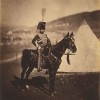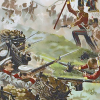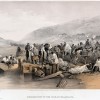Balaklava
Balaklava, now incorporated into Sevastopol, is the site of the charge of the Light Brigade in 1854, memorialized by Tennyson as the epitome of heroic failure during the Crimean War. The Battle of Balaklava resulted in 250 British deaths, thus reducing the cavalry size by two thirds. Related BRANCH article: Stefanie Markovits, “On the Crimean War and the Charge of the Light Brigade”
Coordinates
Latitude: 44.509272639550
Longitude: 33.600096702576
Longitude: 33.600096702576



